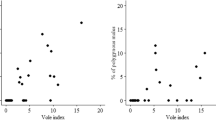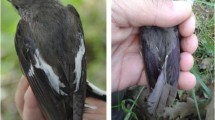Summary
Polyterritorial polygyny in passerine birds, i.e., when already-paired males attract females in secondary territories, has been explained by male deception. Secondary females are assumed to make a poor choice, because they lack information about males' pairing status. To date, the deception hypothesis has focused mainly on the hole-nesting pied flycatcher. In this study of polyterritorial wood warblers, an open-nesting species, secondary females did not differ in number of fledged young compared with females of monogamous males, and they fledged even more young than primary females. Nest predation influenced the allocation of paternal care. Almost half of the secondary females had exclusive male assistance because nests of primary females were preyed upon.
Similar content being viewed by others
References
Alatalo RV, Lundberg A (1984) Polyterritorial polygyny in the pied flycatcher Ficedula hypoleuca — evidence for the deception hypothesis. Ann Zool Fennici 21:217–228
Alatalo RV, Lundberg A (1986) The sexy son hypothesis: data from the pied flycatcher Ficedula hypoleuca. Anim Behav 34:1454–1462
Alatalo RV, Carlson A, Lundberg A, Ulfstrand S (1981) The conflict between male polygamy and female monogamy: the case of the pied flycatcher Ficedula hypoleuca. Am Nat 117:738–753
Alatalo RV, Lundberg A, Ståhlbrandt K (1982) Why do pied flycatcher females mate with already-mated males? Anim Behav 30:585–593
Alatalo RV, Carlson A, Lundberg A, Ulfstrand S (1984) Male deception or female choice in the pied flycatcher Ficedula hypoleuca: A reply. Am Nat 123:282–285
Catchpole C, Leisler B, Winkler H (1985) Polygyny in the great reed warbler Acrocephalus arundinaceus: A possible case of deception. Behav Ecol Sociobiol 16:285–291
Dyrcz A (1986) Factors affecting facultative polygyny and breeding results in the Great Reed Warbler Acrocephalus arundinaceus. J Orn 127:447–461
Gottfried BM, Thompson CF (1978) Experimental analysis of nest predation in an old-field habitat. Auk 95:304–312
Haartman L von (1956) Territory in the pied flycatcher Muscicapa hypoleuca. Ibis 98:460–475
Haartman L von (1969) Nest-site and evolution of polygamy in European passerine birds. Ornis Fenn 46:1–12
Muldal AM, Moffatt JD, Robertson RJ (1986) Parental care of nestlings by male red-winged blackbirds. Behav Ecol Sociobiol 19:105–114
Newton I (1972) Finches. Collins, Glasgow
Nice MM (1957) Nesting success in altricial birds. Auk 74:305–321
Nolan V Jr (1963) Reproductive success of birds in a deciduous scrub habitat. Ecology 44:305–313
Orians GH (1969) On the evolution of mating systems in birds and mammals. Am Nat 103:589–603
Slagsvold T, Lifjeld JT (1986) Mate retention and male polyterritoriality in the pied flycatcher Ficedula hypoleuca. Behav Ecol Sociobiol 19:25–30
Temrin H (1986) Singing behaviour in relation to polyterritorial polygyny in the wood warbler Phylloscopus sibilatrix. Anim Behav 34:146–152
Temrin H (1988) Female pairing options in polyterritorial wood warblers Phylloscopus sibilatrix. Anim Behav (in press)
Temrin H, Mallner Y, Windén M (1984) Observations on polyterritoriality and singing behaviour in the wood warbler Phylloscopus sibilatrix. Ornis Scand 15:67–72
Thompson CF, Nolan V Jr (1973) Population biology of the Yellow-breasted Chat Icteria virens L. in southern Indiana. Ecol Monogr 43:145–171
Tomialojc L, Walianiewics W, Wesolowski T (1984) Breeding bird community of primaeval forest (Bialowieza National Park). Acta Orn 20:241–310
Urano E (1985) Polygyny and the breeding success of the great reed warbler Acrocephalus arundinaceus. Res Popul Ecol 27:393–412
Verner J (1964) Evolution of polygamy in the long-billed marsh wren. Evolution 18:252–261
Verner J, Willson MF (1966) The influence of habitats on mating systems of North American passerine birds. Ecology 47:143–147
Weatherhead PJ, Robertson RJ (1979) Offspring quality and the polygyny threshold: “the sexy son hypothesis”. Am Nat 113:201–208
Wesolowski T (1985) The breeding ecology of the wood warbler Phylloscopus sibilatrix in primaeval forest. Ornis Scand 16:49–60
Wittenberger JF (1976) The ecological factors selecting for polygyny in altricial birds. Am Nat 110:779–799
Wittenberger JF (1980) Feeding of secondary nestlings by polygynous male bobolinks in Oregon. Wilson Bull 92:330–340
Author information
Authors and Affiliations
Rights and permissions
About this article
Cite this article
Temrin, H., Jakobsson, S. Female reproductive success and nest predation in polyterritorial wood warblers (Phylloscopus sibilatrix). Behav Ecol Sociobiol 23, 225–231 (1988). https://doi.org/10.1007/BF00302945
Received:
Accepted:
Issue Date:
DOI: https://doi.org/10.1007/BF00302945




